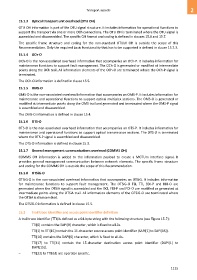Page 1135 - 5G Basics - Core Network Aspects
P. 1135
Transport aspects 2
15.1.3 Optical transport unit overhead (OTU OH)
OTU OH information is part of the OTU signal structure. It includes information for operational functions to
support the transport via one or more OCh connections. The OTU OH is terminated where the OTU signal is
assembled and disassembled. The specific OH format and coding is defined in clauses 15.6 and 15.7.
The specific frame structure and coding for the non-standard OTUkV OH is outside the scope of this
Recommendation. Only the required basic functionality that has to be supported is defined in clause 15.7.3.
15.1.4 OCh-O
OCh-O is the non-associated overhead information that accompanies an OCh-P. It includes information for
maintenance functions to support fault management. The OCh-O is generated or modified at intermediate
points along the OCh trail. All information elements of the OCh-O are terminated where the OCh-P signal is
terminated.
The OCh-O information is defined in clause 15.5.
15.1.5 OMS-O
OMS-O is the non-associated overhead information that accompanies an OMS-P. It includes information for
maintenance and operational functions to support optical multiplex sections. The OMS-O is generated or
modified at intermediate points along the OMS trail and generated and terminated where the OMS-P signal
is assembled and disassembled.
The OMS-O information is defined in clause 15.4.
15.1.6 OTS-O
OTS-O is the non-associated overhead information that accompanies an OTS-P. It includes information for
maintenance and operational functions to support optical transmission sections. The OTS-O is terminated
where the OTS-P signal is assembled and disassembled.
The OTS-O information is defined in clause 15.3.
15.1.7 General management communications overhead (COMMS OH)
COMMS OH information is added to the information payload to create a MOTUm interface signal. It
provides general management communication between network elements. The specific frame structure
and coding for the COMMS OH is outside the scope of this Recommendation.
15.1.8 OTSiG-O
OTSiG-O is the non-associated overhead information that accompanies an OTSiG. It includes information
for maintenance functions to support fault management. The OTSiG-O TSI, TTI, BDI-P and BDI-O are
generated where the OTSiA signal is assembled and the OCI, FDI-P and FDI-O are modified or generated at
intermediate points along the OTSiA trail. All information elements of the OTSiG-O are terminated where
the OTSiA is disassembled.
The OTSiG-O information is defined in clause 15.5.
15.2 Trail trace identifier and access point identifier definition
A trail trace identifier (TTI) is defined as a 64-byte string with the following structure (see Figure 15-7):
TTI[0] contains the SAPI[0] character, which is fixed to all-0s.
TTI[1] to TTI[15] contain the 15-character source access point identifier (SAPI[1] to SAPI[15]).
TTI[16] contains the DAPI[0] character, which is fixed to all-0s.
TTI[17] to TTI[31] contain the 15-character destination access point identifier (DAPI[1] to
DAPI[15]).
TTI[32] to TTI[63] are operator specific.
1125

